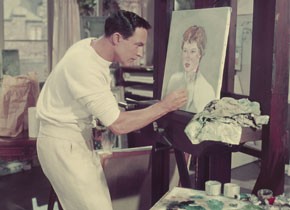Vincente Minnelli
American Dreamer
March 9 to 31, 2007
The oeuvre of Vincente Minnelli (1903–1986) is the perfect embodiment of what might be called "the genius of Hollywood": Minnelli was able to realize his art within the framework of a form determined by others. He represented MGM at its best, the auteur as studio employee (and vice versa).
Unlike many masters of his generation, Minnelli rarely had to struggle with genres where he didn't feel at home. He came from Broadway and was hired as a maker of film musicals. For him, there was almost no dividing line between personality and studio style: Minneli's greatness unfolded most perfectly in those genres which MGM also excelled in and which gained a special character through his vision, namely in musicals and dark melodramas.
It is alongside these two genres that the Retrospective provides a trip into Vincente Minnelli's dream world: a kind of cinema which brings together two seemingly contradictory passions – for fantastic "extravaganzas" and for utterly real feelings, staged on the terrain of a new, semi-real world.
In the mid-1940s, Minnelli’s films ushered in a new era for the musical. In such works as Cabin in the Sky (1943), Meet Me in St. Louis (1944) and The Pirate (1948), he pushed a seamless blend of song and dance numbers, film sets and plot development. He relished an eclectic style which was always over the top, with dazzling colours and "melodious camera movements" (David Thomson), establishing a new standard on the firmament of film musicals. Other masters of the form realized entirely original works for MGM, but their films were always judged by Minnelli’s standard.
The close cooperation with Arthur Freed’s production unit at MGM provided a solid basis (and an incentive) for the continuing development of Minnelli’s experiments with the genre. His "surrealist" set designs and his interest in other art forms – his "low rendez-vous with High Art” (Gary Carey) – reached their climax in the early 1950s. An American in Paris, The Band Wagon and Brigadoon (together with Singin' in the Rain by Gene Kelly and Stanley Donen) epitomize a certain form of pop cinema ecstasy that remains unchallenged to this day.
Around the same time, however, Minnelli also shifted focus. From the early 1950s on, dark melodramas assumed the leading role in his oeuvre. And he found a kindred spirit in MGM producer John Houseman. The Bad and the Beautiful (1952) and Two Weeks in Another Town (1962), representing the beginning and the end of this collaboration, are two of the most outstanding self-portraits Hollywood ever came up with.
Bookended by these two are The Cobweb, an ensemble piece about a psychiatric clinic and a troubled artist, and Lust for Life, a radically aestheticized treatment of the modern art biography, that of Vincent van Gogh. As with The Band Wagon, all these films were inflected with "autobiographical" intentions.
Minnelli's greatest melodramas, his most painful visions of the power of destiny in a godless world, were realized at the end of the decade: Some Came Running (1958) and Home from the Hill (1960), starring Frank Sinatra & Dean Martin and Robert Mitchum respectively, are among the most striking variations on America and violence. They mark the second high point in the filmmaker’s career.
After that, there were only two more occasions for him to truly communicate his genius: the giddy New York musical Bells are Ringing (1960) the Hollywood psychodrama Two Weeks in Another Town. Both films herald the changes of the 1960s, they are the light and dark versions of bidding farewell. Minnelli's time as the untouchable "King of MGM” was over, as was the classical studio era. A specific culture was dying, and it took its protagonists down with it.
